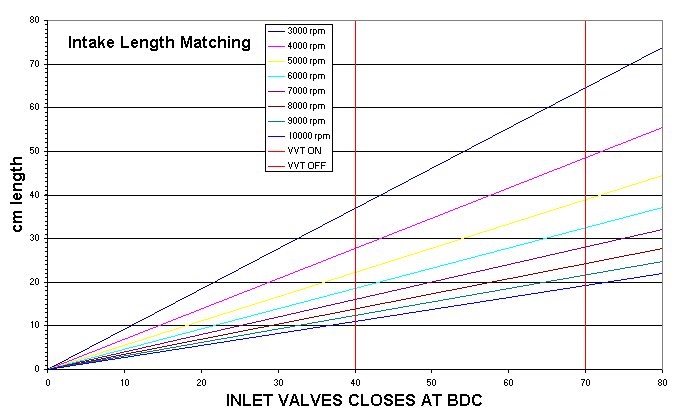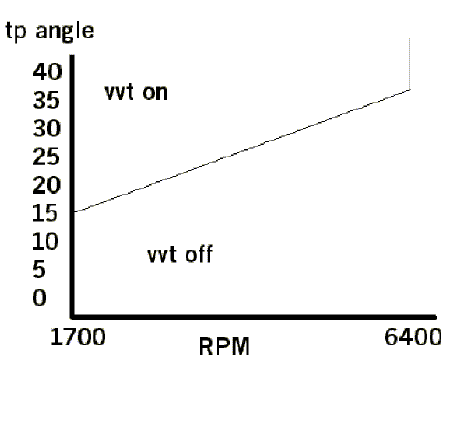
Intake Length Matching
22nd February 2004
A intake pipe length table was found from Bill Sherwood's car section website under "Engines" then "Intro". A restoration of the graph in the new Excel format looks like: -

The rules starts from half way of the engine head's inlet. But 20v's inlet are different length between the centre valve and the side valves of each cylinder, because it is 5 valves per cylinder, so the two differences will be noted and averaged out first: -
11.15 + 12 = 23.15, divide by 2 we get 11.575 and half of it is adopted as around 5.7 cm = 2.39 inches. This settles the engine head's inlet.
Then there is a intake manifold gasket which is as thick as 0.41 cm = 0.161 inches
And each individual throttle is 14.25 cm = 5.61 inches
Finally the plastic "Intake Pipe" closest = 13 cm, furthest = 21 cm, therefore average = 17 cm = 6.69 inches
So, the total length of each cylinder's intake travel is 37.36 = 14.67 inches
The way to use the chart is to first find out the engine's intake valves closes at what degrees when piston is at bottom dead centre (BDC). For Toyota 20v 4A-G: -
Then draw a line from the desired degrees at the bottom of the chart (x-axis) all the way up cutting across all rpm. Like the red colour lines above from 40 and 70.
Next pick off the desired rpm for optimisation and read off the length at the left side bar (y-axis)
For my case / choice of rpm for optimisations are: -
|
After VVT engaged |
Before VVT engaged |
|||
| rpm |
intake approximate inches/cm |
rpm |
intake approximate inches/cm |
|
| 3000 | 14.5 / 36.9 | 3000 | 25.37 / 64.6 | |
| 4000 | 10.9 / 27.7 | 4000 | 19.07 / 48.5 | |
| 7000 | 6.31 / 16.1 | 7000 | 11.04 / 28.1 | |
| 8000 | 5.44 / 13.8 | 8000 | 9.52 / 24.2 | |
Now compare these values to the stock intake length of 14.67 inches = 37.36 cm. We find that it means after VVT engaged the stock intake pipe length will not be optimum for 8,000 rpm. Instead at 3,000 rpm is the strongest.
The scenario changes if VVT does not engaged, which is optimum around 5,000 rpm mark and above.
Currently I do not have the plastic "Intake Pipe" but have a very short adaptor of around 4 cm. This changes the whole story because the total length is around 24.36 cm = 9.57 inches
So, after VVT engaged, best performance is around 4,500 rpm and before VVT engaged, best performance is 8,000 rpm. Too high, not useful.........
The VVT operation is however a complicated issue: - (taken from www.club4ag.com credits goes to them)

It does not turn ON of OFF depending on rpm alone, but taking user's demand for power into consideration by means to estimation from throttle position sensor's angle (TPS).
When full throttle, VVT is ON as early as 1,700 rpm. In fact only very little throttle is required to switch VVT ON, a mere 15 degrees. After 6,400 rpm it switch back OFF.
This means the chart will have to be studied based on VVT ON at 3,000 and 4,000 rpm then VVT OFF at 7,000 and 8,000 rpm. If we look at the chart's reply we can see that the stock Toyota 20v intake length is as closely match to all rpm as possible.
In fact making the total intake length at 27 cm would be more ideal as it covers 3,000 to 5,000 rpm more equally as well as 7,000 to 8,000 rpm.
There is also the question about the butterfly in the middle of the throttle. Perhaps at full throttle is does not pose any significant air-turbulence, but what about partial throttle? surely it affects air flow and may not be applicable to this formula?
Also the intake diameter? as this is associated with port frequency related to port length. So what is the port diameter used / based on the assumption to use the chart correctly?
ACOUSTICS SECTION AUDIO SECTION CAR SECTION
HOME - Technical Website for Acoustics, Audio and Car